Kodak's Failure: A Change Management Analysis of the Digital Shift
VerifiedAdded on 2020/04/21
|17
|3303
|39
Report
AI Summary
This report examines Kodak's failure to successfully transition to digital photography, analyzing the driving forces behind the change, the major issues encountered, and the change management perspectives that contributed to its downfall. It explores potential barriers to change, proposes solutions using Lewin's Change Management Model, and provides an analysis of the need for change within organizations, identifying both internal and external drivers. The report further details the likely impact of proposed changes on a company and its operations, outlines specific and measurable objectives, and utilizes PESTLE and competitor analyses to assess the external environment. It also specifies major change requirements, conducts cost-benefit and risk analyses, and proposes communication plans and strategies for implementation, including resource allocation. Finally, the report describes Prosci's change management methodology, the ADKAR model, the four stages of a Change Curve, and both internal and external drivers of change. The case study also includes a brief analysis of Blockbuster's challenges and strategies.
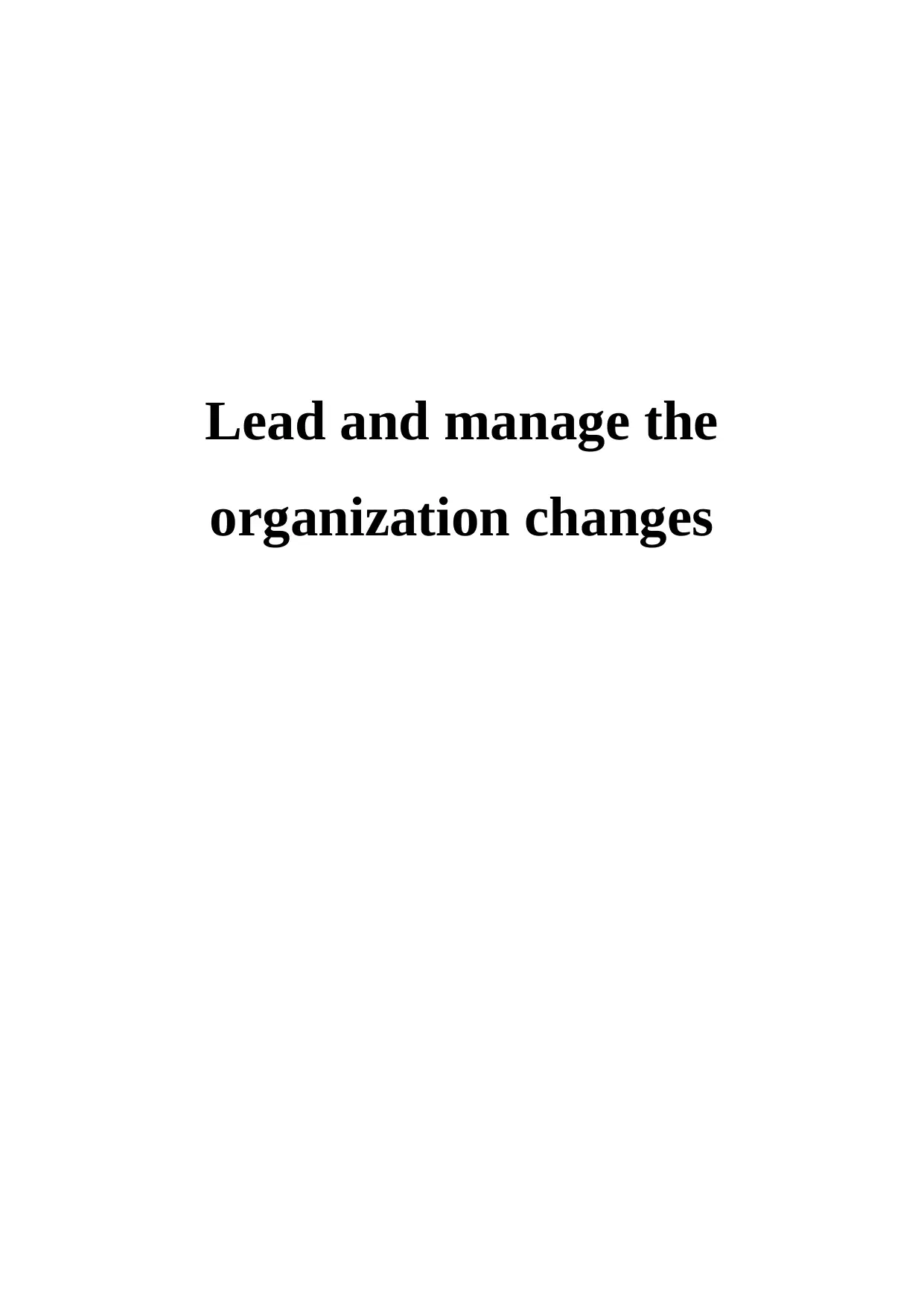
Lead and manage the
organization changes
organization changes
Paraphrase This Document
Need a fresh take? Get an instant paraphrase of this document with our AI Paraphraser
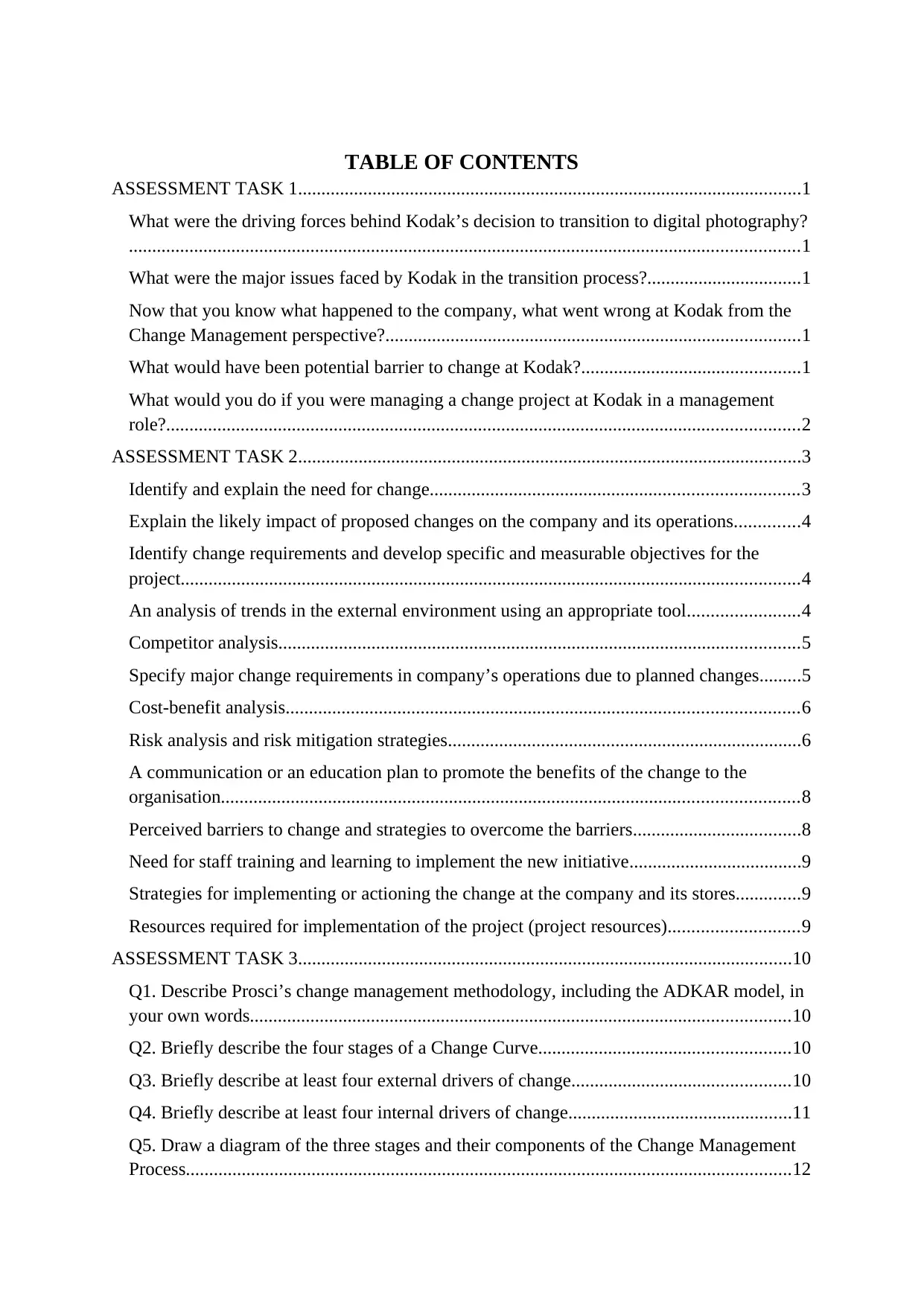
TABLE OF CONTENTS
ASSESSMENT TASK 1............................................................................................................1
What were the driving forces behind Kodak’s decision to transition to digital photography?
................................................................................................................................................1
What were the major issues faced by Kodak in the transition process?.................................1
Now that you know what happened to the company, what went wrong at Kodak from the
Change Management perspective?.........................................................................................1
What would have been potential barrier to change at Kodak?...............................................1
What would you do if you were managing a change project at Kodak in a management
role?........................................................................................................................................2
ASSESSMENT TASK 2............................................................................................................3
Identify and explain the need for change...............................................................................3
Explain the likely impact of proposed changes on the company and its operations..............4
Identify change requirements and develop specific and measurable objectives for the
project.....................................................................................................................................4
An analysis of trends in the external environment using an appropriate tool........................4
Competitor analysis................................................................................................................5
Specify major change requirements in company’s operations due to planned changes.........5
Cost-benefit analysis..............................................................................................................6
Risk analysis and risk mitigation strategies............................................................................6
A communication or an education plan to promote the benefits of the change to the
organisation............................................................................................................................8
Perceived barriers to change and strategies to overcome the barriers....................................8
Need for staff training and learning to implement the new initiative.....................................9
Strategies for implementing or actioning the change at the company and its stores..............9
Resources required for implementation of the project (project resources)............................9
ASSESSMENT TASK 3..........................................................................................................10
Q1. Describe Prosci’s change management methodology, including the ADKAR model, in
your own words....................................................................................................................10
Q2. Briefly describe the four stages of a Change Curve......................................................10
Q3. Briefly describe at least four external drivers of change...............................................10
Q4. Briefly describe at least four internal drivers of change................................................11
Q5. Draw a diagram of the three stages and their components of the Change Management
Process..................................................................................................................................12
ASSESSMENT TASK 1............................................................................................................1
What were the driving forces behind Kodak’s decision to transition to digital photography?
................................................................................................................................................1
What were the major issues faced by Kodak in the transition process?.................................1
Now that you know what happened to the company, what went wrong at Kodak from the
Change Management perspective?.........................................................................................1
What would have been potential barrier to change at Kodak?...............................................1
What would you do if you were managing a change project at Kodak in a management
role?........................................................................................................................................2
ASSESSMENT TASK 2............................................................................................................3
Identify and explain the need for change...............................................................................3
Explain the likely impact of proposed changes on the company and its operations..............4
Identify change requirements and develop specific and measurable objectives for the
project.....................................................................................................................................4
An analysis of trends in the external environment using an appropriate tool........................4
Competitor analysis................................................................................................................5
Specify major change requirements in company’s operations due to planned changes.........5
Cost-benefit analysis..............................................................................................................6
Risk analysis and risk mitigation strategies............................................................................6
A communication or an education plan to promote the benefits of the change to the
organisation............................................................................................................................8
Perceived barriers to change and strategies to overcome the barriers....................................8
Need for staff training and learning to implement the new initiative.....................................9
Strategies for implementing or actioning the change at the company and its stores..............9
Resources required for implementation of the project (project resources)............................9
ASSESSMENT TASK 3..........................................................................................................10
Q1. Describe Prosci’s change management methodology, including the ADKAR model, in
your own words....................................................................................................................10
Q2. Briefly describe the four stages of a Change Curve......................................................10
Q3. Briefly describe at least four external drivers of change...............................................10
Q4. Briefly describe at least four internal drivers of change................................................11
Q5. Draw a diagram of the three stages and their components of the Change Management
Process..................................................................................................................................12
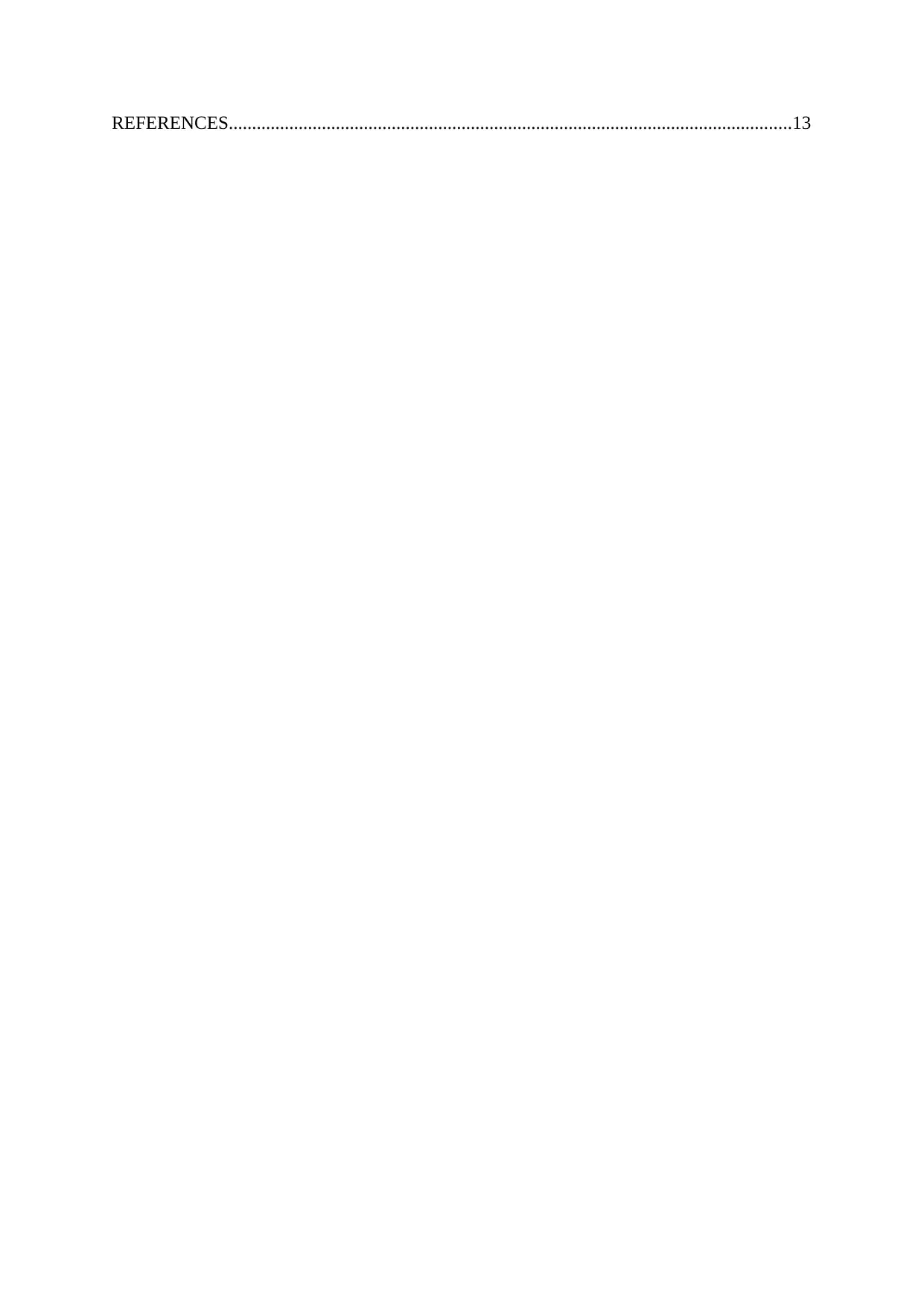
REFERENCES.........................................................................................................................13
⊘ This is a preview!⊘
Do you want full access?
Subscribe today to unlock all pages.

Trusted by 1+ million students worldwide

Paraphrase This Document
Need a fresh take? Get an instant paraphrase of this document with our AI Paraphraser
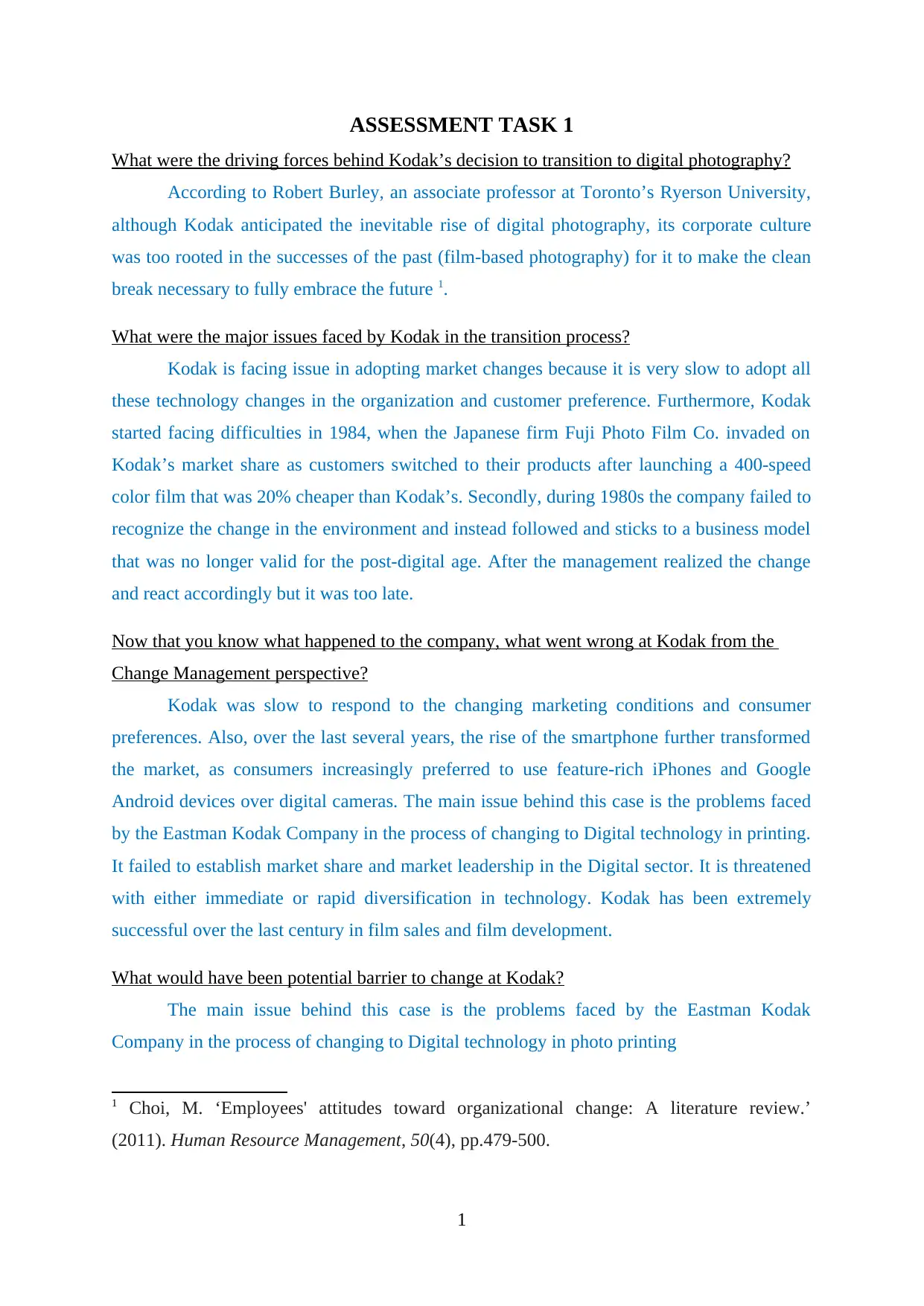
ASSESSMENT TASK 1
What were the driving forces behind Kodak’s decision to transition to digital photography?
According to Robert Burley, an associate professor at Toronto’s Ryerson University,
although Kodak anticipated the inevitable rise of digital photography, its corporate culture
was too rooted in the successes of the past (film-based photography) for it to make the clean
break necessary to fully embrace the future 1.
What were the major issues faced by Kodak in the transition process?
Kodak is facing issue in adopting market changes because it is very slow to adopt all
these technology changes in the organization and customer preference. Furthermore, Kodak
started facing difficulties in 1984, when the Japanese firm Fuji Photo Film Co. invaded on
Kodak’s market share as customers switched to their products after launching a 400-speed
color film that was 20% cheaper than Kodak’s. Secondly, during 1980s the company failed to
recognize the change in the environment and instead followed and sticks to a business model
that was no longer valid for the post-digital age. After the management realized the change
and react accordingly but it was too late.
Now that you know what happened to the company, what went wrong at Kodak from the
Change Management perspective?
Kodak was slow to respond to the changing marketing conditions and consumer
preferences. Also, over the last several years, the rise of the smartphone further transformed
the market, as consumers increasingly preferred to use feature-rich iPhones and Google
Android devices over digital cameras. The main issue behind this case is the problems faced
by the Eastman Kodak Company in the process of changing to Digital technology in printing.
It failed to establish market share and market leadership in the Digital sector. It is threatened
with either immediate or rapid diversification in technology. Kodak has been extremely
successful over the last century in film sales and film development.
What would have been potential barrier to change at Kodak?
The main issue behind this case is the problems faced by the Eastman Kodak
Company in the process of changing to Digital technology in photo printing
1 Choi, M. ‘Employees' attitudes toward organizational change: A literature review.’
(2011). Human Resource Management, 50(4), pp.479-500.
1
What were the driving forces behind Kodak’s decision to transition to digital photography?
According to Robert Burley, an associate professor at Toronto’s Ryerson University,
although Kodak anticipated the inevitable rise of digital photography, its corporate culture
was too rooted in the successes of the past (film-based photography) for it to make the clean
break necessary to fully embrace the future 1.
What were the major issues faced by Kodak in the transition process?
Kodak is facing issue in adopting market changes because it is very slow to adopt all
these technology changes in the organization and customer preference. Furthermore, Kodak
started facing difficulties in 1984, when the Japanese firm Fuji Photo Film Co. invaded on
Kodak’s market share as customers switched to their products after launching a 400-speed
color film that was 20% cheaper than Kodak’s. Secondly, during 1980s the company failed to
recognize the change in the environment and instead followed and sticks to a business model
that was no longer valid for the post-digital age. After the management realized the change
and react accordingly but it was too late.
Now that you know what happened to the company, what went wrong at Kodak from the
Change Management perspective?
Kodak was slow to respond to the changing marketing conditions and consumer
preferences. Also, over the last several years, the rise of the smartphone further transformed
the market, as consumers increasingly preferred to use feature-rich iPhones and Google
Android devices over digital cameras. The main issue behind this case is the problems faced
by the Eastman Kodak Company in the process of changing to Digital technology in printing.
It failed to establish market share and market leadership in the Digital sector. It is threatened
with either immediate or rapid diversification in technology. Kodak has been extremely
successful over the last century in film sales and film development.
What would have been potential barrier to change at Kodak?
The main issue behind this case is the problems faced by the Eastman Kodak
Company in the process of changing to Digital technology in photo printing
1 Choi, M. ‘Employees' attitudes toward organizational change: A literature review.’
(2011). Human Resource Management, 50(4), pp.479-500.
1
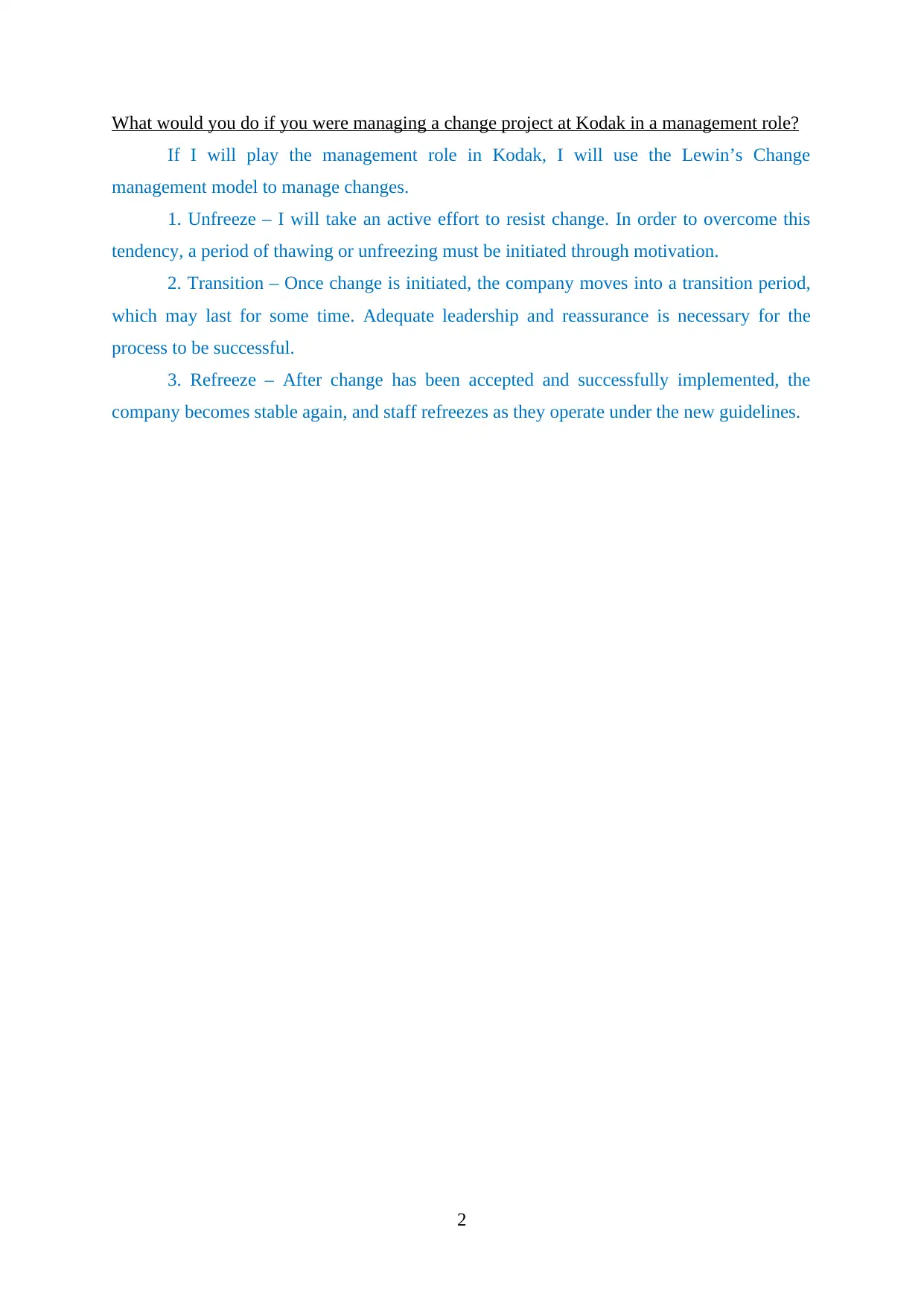
What would you do if you were managing a change project at Kodak in a management role?
If I will play the management role in Kodak, I will use the Lewin’s Change
management model to manage changes.
1. Unfreeze – I will take an active effort to resist change. In order to overcome this
tendency, a period of thawing or unfreezing must be initiated through motivation.
2. Transition – Once change is initiated, the company moves into a transition period,
which may last for some time. Adequate leadership and reassurance is necessary for the
process to be successful.
3. Refreeze – After change has been accepted and successfully implemented, the
company becomes stable again, and staff refreezes as they operate under the new guidelines.
2
If I will play the management role in Kodak, I will use the Lewin’s Change
management model to manage changes.
1. Unfreeze – I will take an active effort to resist change. In order to overcome this
tendency, a period of thawing or unfreezing must be initiated through motivation.
2. Transition – Once change is initiated, the company moves into a transition period,
which may last for some time. Adequate leadership and reassurance is necessary for the
process to be successful.
3. Refreeze – After change has been accepted and successfully implemented, the
company becomes stable again, and staff refreezes as they operate under the new guidelines.
2
⊘ This is a preview!⊘
Do you want full access?
Subscribe today to unlock all pages.

Trusted by 1+ million students worldwide
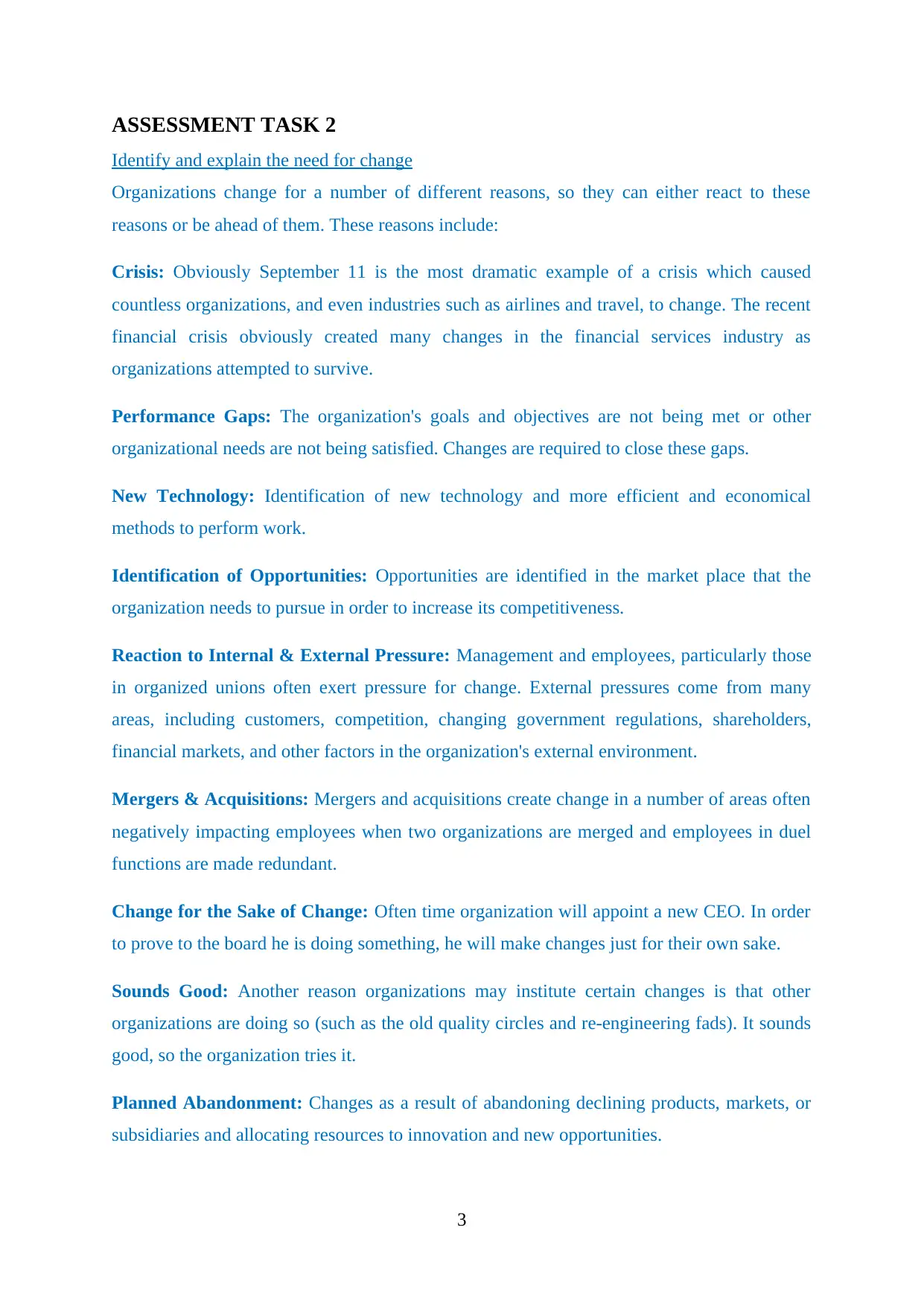
ASSESSMENT TASK 2
Identify and explain the need for change
Organizations change for a number of different reasons, so they can either react to these
reasons or be ahead of them. These reasons include:
Crisis: Obviously September 11 is the most dramatic example of a crisis which caused
countless organizations, and even industries such as airlines and travel, to change. The recent
financial crisis obviously created many changes in the financial services industry as
organizations attempted to survive.
Performance Gaps: The organization's goals and objectives are not being met or other
organizational needs are not being satisfied. Changes are required to close these gaps.
New Technology: Identification of new technology and more efficient and economical
methods to perform work.
Identification of Opportunities: Opportunities are identified in the market place that the
organization needs to pursue in order to increase its competitiveness.
Reaction to Internal & External Pressure: Management and employees, particularly those
in organized unions often exert pressure for change. External pressures come from many
areas, including customers, competition, changing government regulations, shareholders,
financial markets, and other factors in the organization's external environment.
Mergers & Acquisitions: Mergers and acquisitions create change in a number of areas often
negatively impacting employees when two organizations are merged and employees in duel
functions are made redundant.
Change for the Sake of Change: Often time organization will appoint a new CEO. In order
to prove to the board he is doing something, he will make changes just for their own sake.
Sounds Good: Another reason organizations may institute certain changes is that other
organizations are doing so (such as the old quality circles and re-engineering fads). It sounds
good, so the organization tries it.
Planned Abandonment: Changes as a result of abandoning declining products, markets, or
subsidiaries and allocating resources to innovation and new opportunities.
3
Identify and explain the need for change
Organizations change for a number of different reasons, so they can either react to these
reasons or be ahead of them. These reasons include:
Crisis: Obviously September 11 is the most dramatic example of a crisis which caused
countless organizations, and even industries such as airlines and travel, to change. The recent
financial crisis obviously created many changes in the financial services industry as
organizations attempted to survive.
Performance Gaps: The organization's goals and objectives are not being met or other
organizational needs are not being satisfied. Changes are required to close these gaps.
New Technology: Identification of new technology and more efficient and economical
methods to perform work.
Identification of Opportunities: Opportunities are identified in the market place that the
organization needs to pursue in order to increase its competitiveness.
Reaction to Internal & External Pressure: Management and employees, particularly those
in organized unions often exert pressure for change. External pressures come from many
areas, including customers, competition, changing government regulations, shareholders,
financial markets, and other factors in the organization's external environment.
Mergers & Acquisitions: Mergers and acquisitions create change in a number of areas often
negatively impacting employees when two organizations are merged and employees in duel
functions are made redundant.
Change for the Sake of Change: Often time organization will appoint a new CEO. In order
to prove to the board he is doing something, he will make changes just for their own sake.
Sounds Good: Another reason organizations may institute certain changes is that other
organizations are doing so (such as the old quality circles and re-engineering fads). It sounds
good, so the organization tries it.
Planned Abandonment: Changes as a result of abandoning declining products, markets, or
subsidiaries and allocating resources to innovation and new opportunities.
3
Paraphrase This Document
Need a fresh take? Get an instant paraphrase of this document with our AI Paraphraser
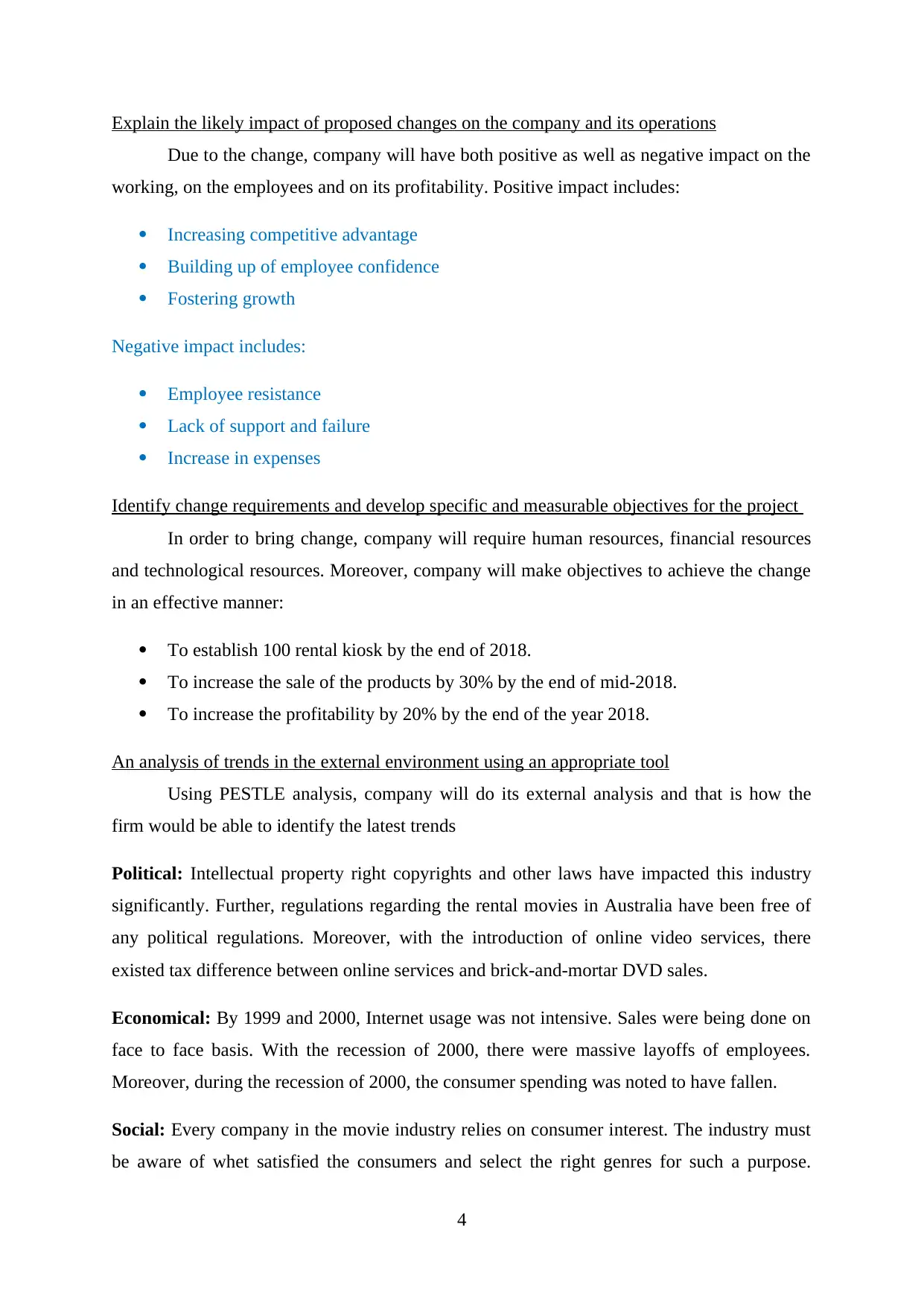
Explain the likely impact of proposed changes on the company and its operations
Due to the change, company will have both positive as well as negative impact on the
working, on the employees and on its profitability. Positive impact includes:
Increasing competitive advantage
Building up of employee confidence
Fostering growth
Negative impact includes:
Employee resistance
Lack of support and failure
Increase in expenses
Identify change requirements and develop specific and measurable objectives for the project
In order to bring change, company will require human resources, financial resources
and technological resources. Moreover, company will make objectives to achieve the change
in an effective manner:
To establish 100 rental kiosk by the end of 2018.
To increase the sale of the products by 30% by the end of mid-2018.
To increase the profitability by 20% by the end of the year 2018.
An analysis of trends in the external environment using an appropriate tool
Using PESTLE analysis, company will do its external analysis and that is how the
firm would be able to identify the latest trends
Political: Intellectual property right copyrights and other laws have impacted this industry
significantly. Further, regulations regarding the rental movies in Australia have been free of
any political regulations. Moreover, with the introduction of online video services, there
existed tax difference between online services and brick-and-mortar DVD sales.
Economical: By 1999 and 2000, Internet usage was not intensive. Sales were being done on
face to face basis. With the recession of 2000, there were massive layoffs of employees.
Moreover, during the recession of 2000, the consumer spending was noted to have fallen.
Social: Every company in the movie industry relies on consumer interest. The industry must
be aware of whet satisfied the consumers and select the right genres for such a purpose.
4
Due to the change, company will have both positive as well as negative impact on the
working, on the employees and on its profitability. Positive impact includes:
Increasing competitive advantage
Building up of employee confidence
Fostering growth
Negative impact includes:
Employee resistance
Lack of support and failure
Increase in expenses
Identify change requirements and develop specific and measurable objectives for the project
In order to bring change, company will require human resources, financial resources
and technological resources. Moreover, company will make objectives to achieve the change
in an effective manner:
To establish 100 rental kiosk by the end of 2018.
To increase the sale of the products by 30% by the end of mid-2018.
To increase the profitability by 20% by the end of the year 2018.
An analysis of trends in the external environment using an appropriate tool
Using PESTLE analysis, company will do its external analysis and that is how the
firm would be able to identify the latest trends
Political: Intellectual property right copyrights and other laws have impacted this industry
significantly. Further, regulations regarding the rental movies in Australia have been free of
any political regulations. Moreover, with the introduction of online video services, there
existed tax difference between online services and brick-and-mortar DVD sales.
Economical: By 1999 and 2000, Internet usage was not intensive. Sales were being done on
face to face basis. With the recession of 2000, there were massive layoffs of employees.
Moreover, during the recession of 2000, the consumer spending was noted to have fallen.
Social: Every company in the movie industry relies on consumer interest. The industry must
be aware of whet satisfied the consumers and select the right genres for such a purpose.
4
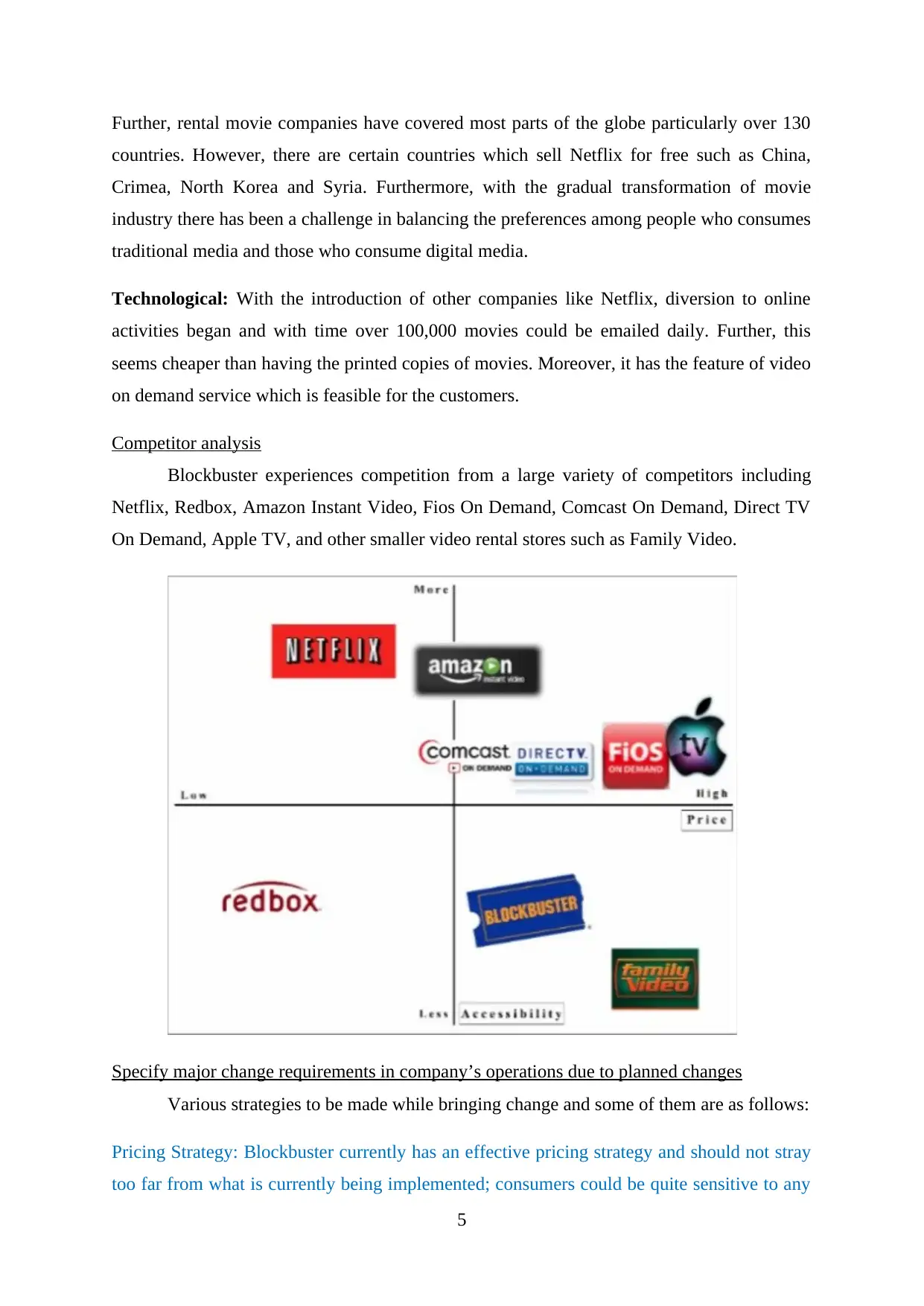
Further, rental movie companies have covered most parts of the globe particularly over 130
countries. However, there are certain countries which sell Netflix for free such as China,
Crimea, North Korea and Syria. Furthermore, with the gradual transformation of movie
industry there has been a challenge in balancing the preferences among people who consumes
traditional media and those who consume digital media.
Technological: With the introduction of other companies like Netflix, diversion to online
activities began and with time over 100,000 movies could be emailed daily. Further, this
seems cheaper than having the printed copies of movies. Moreover, it has the feature of video
on demand service which is feasible for the customers.
Competitor analysis
Blockbuster experiences competition from a large variety of competitors including
Netflix, Redbox, Amazon Instant Video, Fios On Demand, Comcast On Demand, Direct TV
On Demand, Apple TV, and other smaller video rental stores such as Family Video.
Specify major change requirements in company’s operations due to planned changes
Various strategies to be made while bringing change and some of them are as follows:
Pricing Strategy: Blockbuster currently has an effective pricing strategy and should not stray
too far from what is currently being implemented; consumers could be quite sensitive to any
5
countries. However, there are certain countries which sell Netflix for free such as China,
Crimea, North Korea and Syria. Furthermore, with the gradual transformation of movie
industry there has been a challenge in balancing the preferences among people who consumes
traditional media and those who consume digital media.
Technological: With the introduction of other companies like Netflix, diversion to online
activities began and with time over 100,000 movies could be emailed daily. Further, this
seems cheaper than having the printed copies of movies. Moreover, it has the feature of video
on demand service which is feasible for the customers.
Competitor analysis
Blockbuster experiences competition from a large variety of competitors including
Netflix, Redbox, Amazon Instant Video, Fios On Demand, Comcast On Demand, Direct TV
On Demand, Apple TV, and other smaller video rental stores such as Family Video.
Specify major change requirements in company’s operations due to planned changes
Various strategies to be made while bringing change and some of them are as follows:
Pricing Strategy: Blockbuster currently has an effective pricing strategy and should not stray
too far from what is currently being implemented; consumers could be quite sensitive to any
5
⊘ This is a preview!⊘
Do you want full access?
Subscribe today to unlock all pages.

Trusted by 1+ million students worldwide
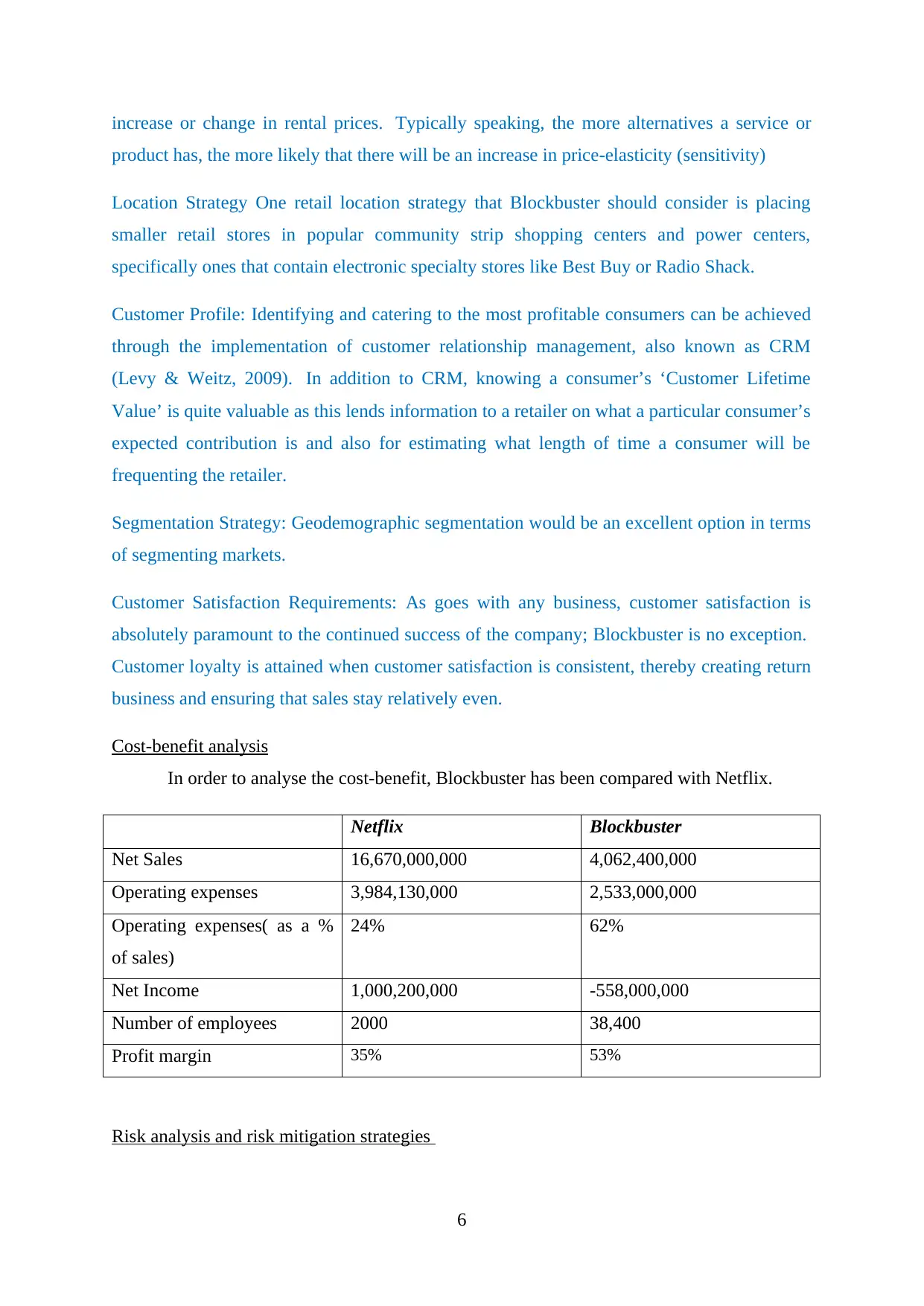
increase or change in rental prices. Typically speaking, the more alternatives a service or
product has, the more likely that there will be an increase in price-elasticity (sensitivity)
Location Strategy One retail location strategy that Blockbuster should consider is placing
smaller retail stores in popular community strip shopping centers and power centers,
specifically ones that contain electronic specialty stores like Best Buy or Radio Shack.
Customer Profile: Identifying and catering to the most profitable consumers can be achieved
through the implementation of customer relationship management, also known as CRM
(Levy & Weitz, 2009). In addition to CRM, knowing a consumer’s ‘Customer Lifetime
Value’ is quite valuable as this lends information to a retailer on what a particular consumer’s
expected contribution is and also for estimating what length of time a consumer will be
frequenting the retailer.
Segmentation Strategy: Geodemographic segmentation would be an excellent option in terms
of segmenting markets.
Customer Satisfaction Requirements: As goes with any business, customer satisfaction is
absolutely paramount to the continued success of the company; Blockbuster is no exception.
Customer loyalty is attained when customer satisfaction is consistent, thereby creating return
business and ensuring that sales stay relatively even.
Cost-benefit analysis
In order to analyse the cost-benefit, Blockbuster has been compared with Netflix.
Netflix Blockbuster
Net Sales 16,670,000,000 4,062,400,000
Operating expenses 3,984,130,000 2,533,000,000
Operating expenses( as a %
of sales)
24% 62%
Net Income 1,000,200,000 -558,000,000
Number of employees 2000 38,400
Profit margin 35% 53%
Risk analysis and risk mitigation strategies
6
product has, the more likely that there will be an increase in price-elasticity (sensitivity)
Location Strategy One retail location strategy that Blockbuster should consider is placing
smaller retail stores in popular community strip shopping centers and power centers,
specifically ones that contain electronic specialty stores like Best Buy or Radio Shack.
Customer Profile: Identifying and catering to the most profitable consumers can be achieved
through the implementation of customer relationship management, also known as CRM
(Levy & Weitz, 2009). In addition to CRM, knowing a consumer’s ‘Customer Lifetime
Value’ is quite valuable as this lends information to a retailer on what a particular consumer’s
expected contribution is and also for estimating what length of time a consumer will be
frequenting the retailer.
Segmentation Strategy: Geodemographic segmentation would be an excellent option in terms
of segmenting markets.
Customer Satisfaction Requirements: As goes with any business, customer satisfaction is
absolutely paramount to the continued success of the company; Blockbuster is no exception.
Customer loyalty is attained when customer satisfaction is consistent, thereby creating return
business and ensuring that sales stay relatively even.
Cost-benefit analysis
In order to analyse the cost-benefit, Blockbuster has been compared with Netflix.
Netflix Blockbuster
Net Sales 16,670,000,000 4,062,400,000
Operating expenses 3,984,130,000 2,533,000,000
Operating expenses( as a %
of sales)
24% 62%
Net Income 1,000,200,000 -558,000,000
Number of employees 2000 38,400
Profit margin 35% 53%
Risk analysis and risk mitigation strategies
6
Paraphrase This Document
Need a fresh take? Get an instant paraphrase of this document with our AI Paraphraser
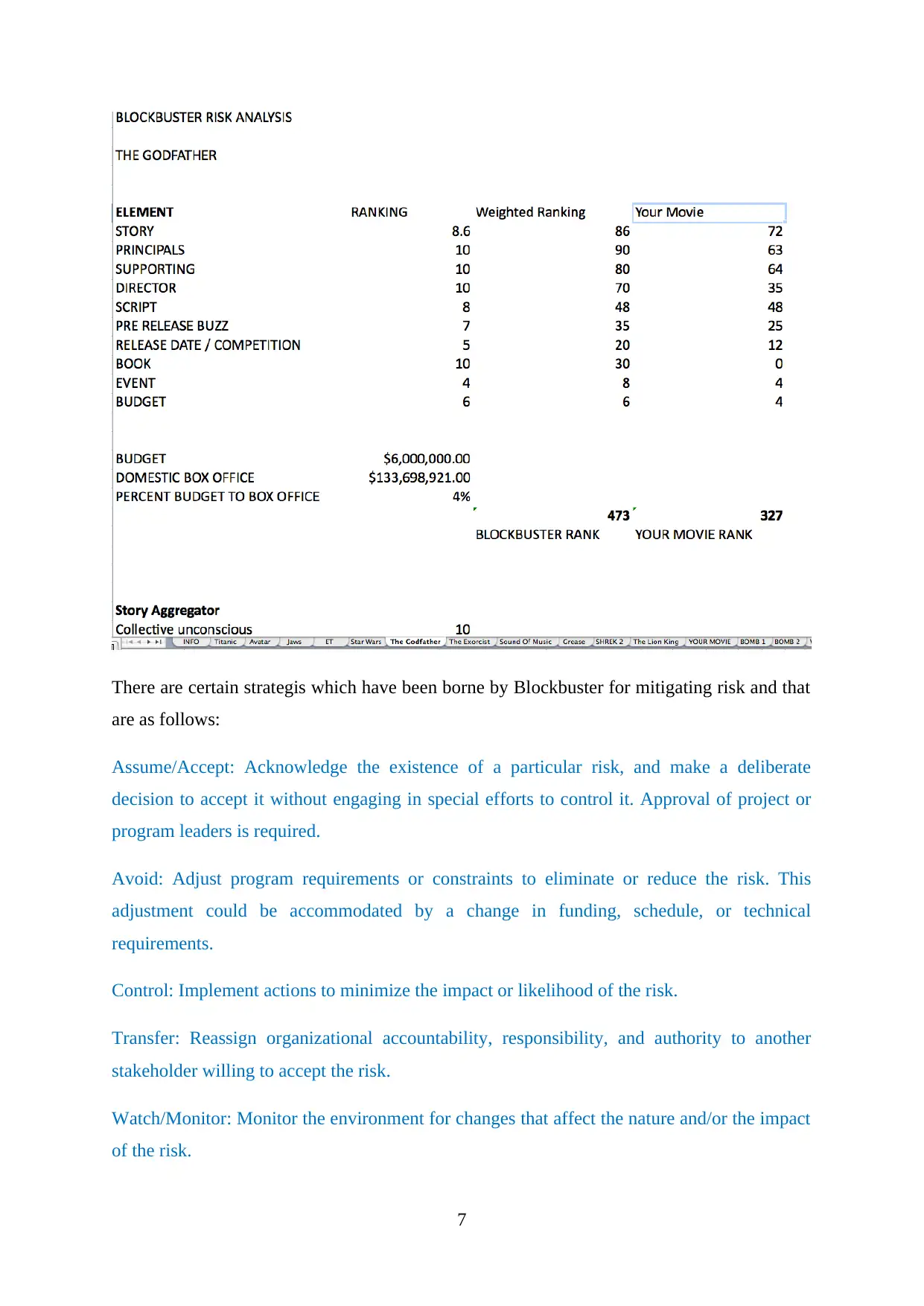
There are certain strategis which have been borne by Blockbuster for mitigating risk and that
are as follows:
Assume/Accept: Acknowledge the existence of a particular risk, and make a deliberate
decision to accept it without engaging in special efforts to control it. Approval of project or
program leaders is required.
Avoid: Adjust program requirements or constraints to eliminate or reduce the risk. This
adjustment could be accommodated by a change in funding, schedule, or technical
requirements.
Control: Implement actions to minimize the impact or likelihood of the risk.
Transfer: Reassign organizational accountability, responsibility, and authority to another
stakeholder willing to accept the risk.
Watch/Monitor: Monitor the environment for changes that affect the nature and/or the impact
of the risk.
7
are as follows:
Assume/Accept: Acknowledge the existence of a particular risk, and make a deliberate
decision to accept it without engaging in special efforts to control it. Approval of project or
program leaders is required.
Avoid: Adjust program requirements or constraints to eliminate or reduce the risk. This
adjustment could be accommodated by a change in funding, schedule, or technical
requirements.
Control: Implement actions to minimize the impact or likelihood of the risk.
Transfer: Reassign organizational accountability, responsibility, and authority to another
stakeholder willing to accept the risk.
Watch/Monitor: Monitor the environment for changes that affect the nature and/or the impact
of the risk.
7
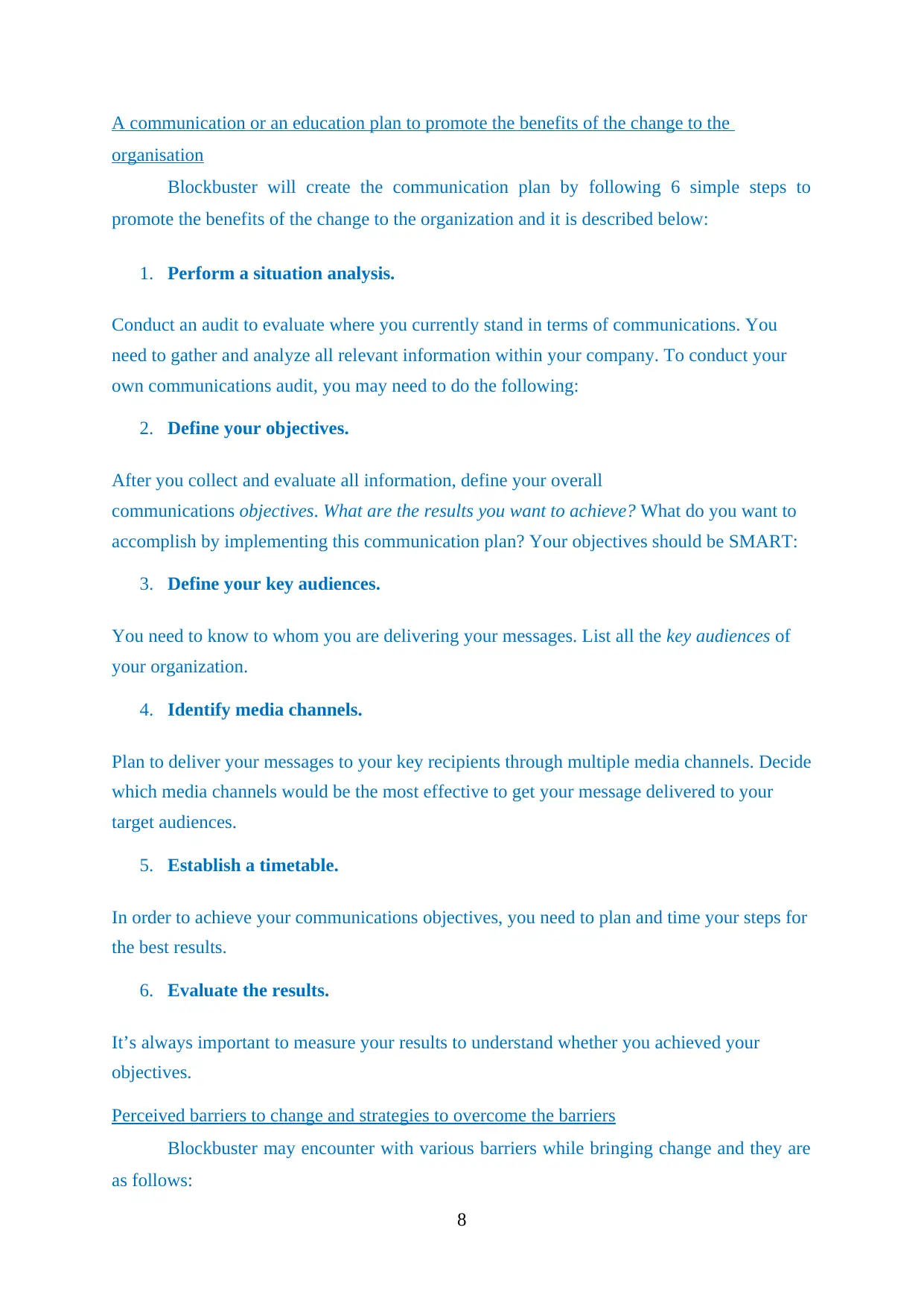
A communication or an education plan to promote the benefits of the change to the
organisation
Blockbuster will create the communication plan by following 6 simple steps to
promote the benefits of the change to the organization and it is described below:
1. Perform a situation analysis.
Conduct an audit to evaluate where you currently stand in terms of communications. You
need to gather and analyze all relevant information within your company. To conduct your
own communications audit, you may need to do the following:
2. Define your objectives.
After you collect and evaluate all information, define your overall
communications objectives. What are the results you want to achieve? What do you want to
accomplish by implementing this communication plan? Your objectives should be SMART:
3. Define your key audiences.
You need to know to whom you are delivering your messages. List all the key audiences of
your organization.
4. Identify media channels.
Plan to deliver your messages to your key recipients through multiple media channels. Decide
which media channels would be the most effective to get your message delivered to your
target audiences.
5. Establish a timetable.
In order to achieve your communications objectives, you need to plan and time your steps for
the best results.
6. Evaluate the results.
It’s always important to measure your results to understand whether you achieved your
objectives.
Perceived barriers to change and strategies to overcome the barriers
Blockbuster may encounter with various barriers while bringing change and they are
as follows:
8
organisation
Blockbuster will create the communication plan by following 6 simple steps to
promote the benefits of the change to the organization and it is described below:
1. Perform a situation analysis.
Conduct an audit to evaluate where you currently stand in terms of communications. You
need to gather and analyze all relevant information within your company. To conduct your
own communications audit, you may need to do the following:
2. Define your objectives.
After you collect and evaluate all information, define your overall
communications objectives. What are the results you want to achieve? What do you want to
accomplish by implementing this communication plan? Your objectives should be SMART:
3. Define your key audiences.
You need to know to whom you are delivering your messages. List all the key audiences of
your organization.
4. Identify media channels.
Plan to deliver your messages to your key recipients through multiple media channels. Decide
which media channels would be the most effective to get your message delivered to your
target audiences.
5. Establish a timetable.
In order to achieve your communications objectives, you need to plan and time your steps for
the best results.
6. Evaluate the results.
It’s always important to measure your results to understand whether you achieved your
objectives.
Perceived barriers to change and strategies to overcome the barriers
Blockbuster may encounter with various barriers while bringing change and they are
as follows:
8
⊘ This is a preview!⊘
Do you want full access?
Subscribe today to unlock all pages.

Trusted by 1+ million students worldwide
1 out of 17
Related Documents
Your All-in-One AI-Powered Toolkit for Academic Success.
+13062052269
info@desklib.com
Available 24*7 on WhatsApp / Email
![[object Object]](/_next/static/media/star-bottom.7253800d.svg)
Unlock your academic potential
Copyright © 2020–2025 A2Z Services. All Rights Reserved. Developed and managed by ZUCOL.





